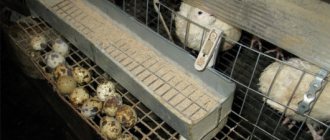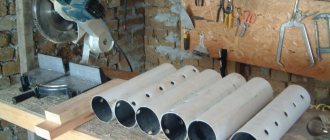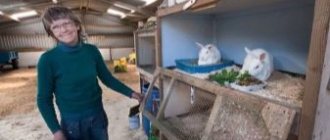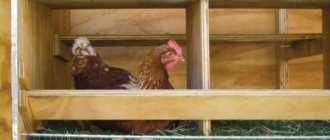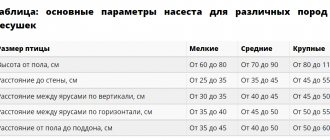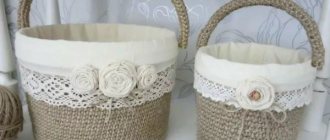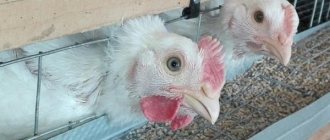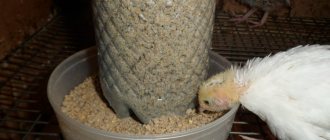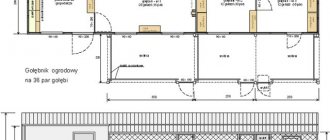When raising chickens, special attention must be paid to proper organization of the feeding process. To do this, first of all, you will need to acquire high-quality and convenient feeders. They can be purchased at a specialized store or made with your own hands using available materials and patterns. What kind of feeders should be and how to make them with your own efforts, read below.
Requirements for feeders
A feeder for laying hens or broilers must have a number of characteristics:
- Made from durable material . To make a feeder, you need to use durable material that has a minimal tendency to deform and deteriorate during use. In addition, the material should not have harmful properties, otherwise it may negatively affect the health of chickens during feeding.
- Has optimal sizes . The feeder must have sufficient volume to feed the entire population of birds throughout the whole day. To determine the optimal size, it is worth considering the following norm: 10-15 cm of length should be allocated for each chicken in the feeder. For chickens, this norm is reduced by 2 times. However, if the tray has a circular shape, then 2.5 cm is enough for each individual. It is advisable that all birds have access to food at the same time, otherwise stronger individuals will push aside the weaker ones.
- Unpretentious in maintenance . You will have to fill the feeder every day. In addition, it must be cleaned and washed regularly, as well as disinfected. All these processes should not cause difficulties for the breeder. For these purposes, it is better to make non-bulky structures that can be easily moved, washed and carried out other manipulations to prepare it for further use.
- Ensures rational distribution of feed . The feeder should be designed in such a way that chickens cannot climb into it, scatter food and spoil it with their excrement. For these purposes, care should be taken to install protective sides, turntables and other devices to the feeder to strengthen the main feed mass inside the container. In addition, the shape of the feeder must be stable so that the birds do not tip it over.
The feeder must be arranged in such a way that all chickens have access to food, and stronger individuals do not crowd out weaker birds.
Definition
A bunker feeder consists of a closed hopper into which food is poured and a tray from which the chickens peck this food.
On the Internet and specialized magazines there are quite a lot of descriptions and drawings of feeders for self-production in the country.
The most common feeders due to their low cost and ease of manufacture are:
- Feeder from water pipes (read about how to make a feeder for chickens with your own hands from sewer, polypropylene, plastic pipes here).
- Plastic and plywood feeder.
- Bucket.
Advantages
Several chickens have free access to feed in the tray at the same time. Each chicken is allocated 8-10 cm of feeder space. For chickens, 4-5 cm is enough.
- Simplicity of design. The feeder is used every day, gets dirty quickly and requires regular cleaning and disinfection. The design of any homemade feeder is lightweight, portable and can be disassembled without much difficulty.
- Sustainability. To prevent chickens from knocking over the feeder and spilling food, it is made stable or firmly fixed to the wall
- Closedness. Chickens do not have the opportunity to climb into the feed bunker and scatter it with their paws.
- Capacity. The feeder holds 10-20 kg. feed at the same time, providing a whole day's supply for a large number of birds
Flaws
- Hopper feeders are designed for dry food only. A complete diet for chickens includes wet mash, fresh herbs, vegetables and fruits that are not able to feed themselves from the hopper.
- The need for regular cleaning and disinfection.
Prices in stores
In specialized stores for amateur gardeners and farming, you can buy an industrial feeder. If you take a cheap Chinese feeder, then it’s just throwing money away . A high-quality automatic one may not be affordable for everyone (you can find out more about how to make an automatic chicken feeder with your own hands here).
Feeders for 10-20 kg cost 1100-1300 rubles in stores. Prices for automatic feeders for 70 kg reach up to 10,000 rubles.
Making a bunker feeder with your own hands is not difficult. The materials will only cost a few hundred rubles. Some materials are probably lying underfoot: boards, plastic buckets, barrels, bottles and pipes.
We talked more about how to make a chicken feeder from a 5-liter plastic bottle in this material.
Types of structures
They are classified according to various parameters, each of which will be considered separately.
By material
Properly selected material for the feeder is the key to preserving the feed, and therefore saving it. It could be:
- Tree. Wooden feeders are one of the most common options, as they are perfect for pouring dry food - grain, animal feed, and various mineral supplements. In addition, wood is a natural material that provides the product with durability.
Wooden feeders should not be used for raw food, since its remains will stick in hard-to-reach areas of the structure, and then begin to rot and contaminate fresh food with pathogenic bacteria.
- Plastic . Chickens must be given mash in their diet. It is best to pour wet food into plastic feeders, since food debris can be easily removed from their surface. However, in this case, special attention will need to be paid to the choice of high-strength plastic.
- Metal . Like the previous material, it is suitable for making containers into which wet mixed food can be poured. It can also be used to make green grass bins. However, it is worth considering that black material tends to rust when exposed to moisture, and stainless steel is quite expensive.
Feeders for chickens are mainly made of wood and plastic, the choice among which depends on what kind of food you plan to use the tray for in the future.
According to the method of feeding
Depending on the type of food supplied to the feeder, the convenience of feeding the bird will depend, because it is much more convenient to pour feed once a day, rather than several times at short intervals. Here are the optimal feeders for the type of food served:
- Tray . The simplest designs that are suitable for feeding young animals. The tray model is a simple container with sides that prevent food from spilling out. As a rule, such a feeder has an elongated shape.
- Grooved . Such designs are complemented by a turntable or a removable demarcation grid (mesh). Inside they are divided by partitions into several compartments (compartments) intended for different types of food. Trough feeders can be placed outside the cage so that hens can reach the feed with their heads only. This will greatly simplify not only the feeding process, but also cleaning the container.
- Bunker (automatic) . Used to supply dry food. Their main advantage is that the breeder only needs to pour feed or grain into the feeder in the morning. This volume will be enough for the birds to feed all day long. The design of such devices is made in such a way that the feed comes from a closed hopper into the trays as needed, so it does not become dirty throughout the day and remains dry.
By location
Depending on the location in the chicken coop, there are two types of feeders:
- floor-mounted – mobile structures that can be installed in any part of the cage or poultry house;
- hinged - structures that, using special brackets or holding devices, are fixed to the wall of the poultry house, therefore they are stable, which compares favorably with mobile feeders that can be overturned by chickens.
Some poultry keepers use both types of feeders at the same time, as each has its own advantages.
How to choose a feeder in a store?
We recommend reading our other articles
- How to make feed for rabbits
- Description of the Manchurian quail breed
- Recipes for lecho with carrots
- What to feed chickens for prevention
A lot of bunker types of chicken feeders are sold in stores. But how to choose a good design in each individual case?
- The material can be anything (glass, plastic, wood, etc.).
At the same time, you need to understand that plastic is not the most reliable option and is most often purchased for chicks, not adults. As for glass, it is a dangerous and expensive material. Range of bunker feeders - Now about the manufacturers. The cooler the company, the higher the price, everyone knows about this. But not many people know that the same “China” can be either branded or low-quality. Branded products are always distinguished by high quality products, regardless of the country of manufacture. It is not profitable to buy fakes; they spoil too quickly.
- The size depends on the number of chickens, their age and type. The point of using a bunker feeder is to visit the chicken coop less often, but if you take a small feeder for an adult bird, you will still have to add feed often. Therefore, it is better to take more than less if there is any doubt.
- The safety of the structure plays an important role. Birds can peck at it, jump on top, push it. It is important that the feeder does not have sharp corners or edges; the material is selected as safe, natural or at least harmless as possible.
Varieties of homemade wooden feeders
There are various options for wooden feeders, which we suggest you familiarize yourself with in more detail.
Hopper feeder made from pieces of wood
Excellent for those breeders who do not have the opportunity to periodically add grain.
To assemble such a structure, first of all, you need to prepare:
- boards made of durable plywood or wood;
- electric drill, set of drills;
- a couple of loops;
- sandpaper;
- saw;
- screwdriver;
- pencil;
- roulette
The instructions for making a bunker feeder look like this:
- Draw a drawing, which is then transferred to the tree, carefully drawing out the details of the future structure:
- bottom – 29x17 cm;
- two side walls 40 cm high, 29 cm long (you will need to cut a wedge in the side walls, as shown in the diagram below);
- two rectangles for the front wall - 28x29 and 7x29 cm;
- top cover – 26x29 cm;
- back wall – 40x29 cm.
- Cut out all the parts, moving along the drawn marker lines.
- Drill holes for screws in the required places using an electric drill.
- Sand the entire surface so that the feeder is smooth and safe for birds.
- Assemble all elements into a single structure using screws. To achieve maximum density, a clamp should be used. In addition, it is worth considering that the back and front walls must be connected at an angle of 15°.
- Attach the cover to the back of the side walls using hinges.
- Treat the feeders with an antiseptic, remembering that the use of paints and varnish is strictly prohibited.
The assembled feeder will be spacious and convenient, operating in automatic mode.
An example of a bunker feeder assembled from wooden blocks is given in the following video:
Feeder in the form of a trough
It is a simpler design, suitable for those who keep a large number of chickens.
To assemble the structure you will need:
- thick boards or plywood;
- hammer;
- screws or nails;
- saw;
- pencil;
- roulette.
The feeder can be assembled according to the following instructions:
- Draw a diagram of the future feeder, accurately defining all the elements, their dimensions and installation locations for fasteners.
- Transfer the drawing to the tree in compliance with the parameters specified in the drawing above.
- Cut out all the design details along the marker lines. It should be borne in mind that the bottom must be thick and heavy, otherwise the birds will be able to easily turn the feeder over. In addition, the height of the walls should be comfortable for chickens.
- Connect all the parts together, leaving no gaps, since through them the food will get out. There is no need to further process the wood.
This feeder is durable and strong, and is also universal regarding the type of food used, that is, it is suitable for feeding both dry and wet food.
How to assemble a wooden chicken feeder is explained and shown in the following video:
Two-story feeder
This option is primarily used for dry food, although a variety of mash can also be served in it. Such a feeder can be made for a small room, since the second tier allows you to compensate for the lack of free space. It looks like this:
Having prepared the bars and screws, you can begin assembling the feeder:
- Prepare all the details of the future feeder. Among them, the main one is the lower tier, 40 cm long and 50 cm wide. The length can be adjusted according to the number of livestock. The second floor is a small filling bunker - a trough with a front wall height of 10 cm and a back wall of 20 cm.
- Make a flap that will divide the lower tier into 1/3 parts.
- Install the second floor on the ends of the first.
- Attach a lid that will cover the food from debris getting inside.
Improving the feeder with a pedal with a dispenser
The hopper-type feeder, improved by a dispenser, was invented by a farmer from Australia. The design is intended for feeding a small number of chickens. If necessary, it is better to make them larger, but not increase the size in any way. Otherwise, the dispenser mechanism will not be able to operate.
The operating principle of the design is simple. There is a wide pedal installed in front of the plywood tray. It is connected to the tray lid by rods made of wooden slats. When the chicken steps on the pedal, it goes down. At this time, the rods lift the lid of the tray where the food is poured. When the chicken comes off the pedal, the lid will cover the tray again.
A feeder made from wood yourself will last longer if it is impregnated with a protective antiseptic. It is undesirable to use varnishes and paints, as they can harm the health of chickens.
Types of feeders made of PVC pipes
To make plastic feeders, farmers often use PVC pipes because they are unpretentious and quite practical - they do not need to be drilled, welded or glued. We will consider various options for feeders made from such pipes below.
With tee
This design has a “standing” shape. To make it you will need:
- sewer pipe 1 m long;
- 2 plugs for PVC pipes of the appropriate size;
- 45° tee;
- a device for cutting plastic pipes or a saw for metal.
The instructions for making a tee feeder look like this:
- Cut the plastic pipe into 3 parts - 70 cm, 20 cm and 10 cm. It should be noted that you can initially purchase pipes of the required sizes so that you do not have to cut them later.
- Take a pipe 20 cm long and put a plug on one end. In this way, it will be possible to obtain the base, that is, the bottom of the structure.
- Place a tee on the other end of the pipe with the side elbow facing up.
- Insert a 10 cm long pipe into the side hole until it stops.
- Insert a 70 cm long pipe into the third hole of the tee and close it with a second plug from the other end to obtain the finished structure.
The assembled feeder should be attached to the wall of the chicken coop at both ends (lower and upper) with wire. Of course, it’s easier to fix it on an iron mesh or support rails. Once the feeder is in place, it can be filled with food. Chickens will peck food from the side hole of the tee without scattering it on the ground. For 15-20 broilers or 30 laying hens, this amount of feed will be enough for a day.
At night, the top of the feeder must be closed with a plug, otherwise foreign objects, debris and bacteria will get into the feed.
What a feeder made from a sewer pipe looks like is shown in the following video:
With cutouts
This design will consist of two pipes, one of which will be installed horizontally and will serve to feed birds, and the other will be installed vertically and will serve to supply grain.
Here are the necessary materials and tools:
- 2 pieces of pipe – 50 cm and 30 cm or 60 cm and 40 cm;
- PVC elbow to fit the pipe size;
- 2 plugs;
- drill, jigsaw or power saw.
The procedure for making a feeder is as follows:
- On a long pipe, draw 2 or more holes with a diameter of 7 cm and with the same spacing. They can be oval, round or rectangular in shape.
- Make a hole with a drill and then cut it out with a jigsaw. If desired, cutouts can be made on both sides.
- Place a plug on one end of the pipe, and install an elbow on the other end into which to insert another pipe.
- Attach the finished feeder to the wall of the chicken coop using wire. It is best to fix it on both sides - top and bottom. As in the previous version, you need to pour grain into the upper pipe, and then close the hole with a second plug so that debris does not get into it. This structure needs to be filled 1-2 times a day.
The method of making a feeder with two rectangular holes is demonstrated in the following video:
DIY pig feeder
Plastic barrel
Any disused barrel will do. The main thing is to make sure that it was not used for storing pesticides.
What should be on hand:
- large capacity plastic barrel;
- wooden bars;
- several screws;
- felt-tip pen;
- electric jigsaw;
- sandpaper.
Step-by-step instruction:
- Divide the barrel into several parts, for example, 4. Apply appropriate markings.
- Using an electric jigsaw, cut the plastic along the contour lines into 4 even pieces.
- Sand all sharp edges and sand with sandpaper.
- The legs are made of bars and attached to the sides of the structure using screws.
- The feed container is ready and can be placed with the animals.
Using a gas cylinder
Such a thing exists in any household. It is not necessary to get rid of an unnecessary cylinder and think about where to donate it. If you have pigs on your farm, you can make a strong and durable feed container. The service life of such a structure is at least two decades.
What tools will you need:
- used cylinder;
- a brush and a solution with added soap to check if there is any gas left in the container;
- a large amount of water;
- scissors for cutting metal;
- Bulgarian;
- reinforcing bars;
- metal corners;
- gas stove;
- welding machine.
Step by step instructions:
- Open the valve on the gas cylinder fully. Residual gas (if any) must be released. You can check with a soap solution, which is applied to the outlet hole. If there is no inflated bubble, you can begin work.
- The cylinder must be turned on one side and the valve must be cut off using scissors. The next part must be done with an assistant. While sawing work is going on, you need to water the cut to prevent heating and sparks.
- Then the container must be filled completely with water, shaking it periodically to get rid of condensation. Used water should be poured as far as possible from living areas.
- It is necessary to determine the desired depth of the feeder. If you intend to use the container for sows and young animals, then the container must be divided in half. Make one half larger and the other smaller. If feeders are needed by adult animals, then the container must be divided into 2 equal parts horizontally.
- For sawing you need to take a grinder.
- To prevent pigs from getting into the feed container, you need to weld reinforcement on top of the structure.
- To completely destroy the gas smell, you need to use a gas burner and fire it.
- The remaining reinforcement is used to create strong legs.
- The feeder is ready and can be used.
Feeder from a gas cylinder
How to use pipes
A ceramic or asbestos cement pipe is suitable for making feeders. The durability of the materials will make the container suitable for long-term use on the farm.
What you will need for production:
- pipe, its length must correspond to the number of livestock;
- boards or cement mortar;
- reinforcing bars;
- welding machine;
- Bulgarian;
- Master OK;
- electric jigsaw, saw.
How to make a pig feeder:
- Cut the pipe to the required length horizontally.
- It is worth considering that such a structure is best made stationary, and therefore you need to take care in advance of choosing a place in the room for the animals, and create concrete supports there.
- Install the pipe with plugs at the edges. Concrete or wooden planks are suitable for their manufacture.
- The remaining reinforcement will be used to create a kind of mesh that will prevent animals from entering the feeding container.
- The design is ready and can be used for its intended purpose.
Feeder for piglets from a pipe
Hopper feeder for broilers
Such a feeder can be made for broilers over 2 weeks old, and it will take no more than 20-30 minutes. One load is enough to feed 30 chickens throughout the day.
To assemble the feeder you will need:
- a piece of plywood or wooden board measuring 20x20 cm and 8-10 mm thick (the thicker the base, the more stable the finished structure will be);
- plastic canister measuring 20x20 cm;
- PVC pipe for sewerage (a section 10-15 cm high) and for water supply (a section 25-30 cm high);
- tape or tape;
- mounting angles, nuts, screws, nails;
- hammer, saw, awl and piece of rope.
Having prepared everything you need, you can begin assembling the feeder:
- Attach a wide piece of pipe to the base of the structure (plywood or board) using mounting angles and screws. It is enough to attach 2 corners opposite each other on the inside of the pipe.
- Take a smaller pipe and cut it along the diameter of the hole to a height of 10-15 cm. Next, make a transverse cut, which should coincide with the longitudinal one. This will create a pipe with half of the lower part cut out.
- Insert a thin pipe inside with a wide thread inside the feeder, and then connect both pipes with two screws - top and bottom.
- Cut off the bottom of the plastic canister, and then place its neck on a narrow pipe. The joint should be wrapped with tape or tape.
- In the canister, closer to the top, make a hole through which to stretch the rope.
- On the wall where you plan to install the feeder, nail a nail at the level of the rope. Secure the structure so that it is stable and the chickens cannot turn it over.
The following video suggests learning more about the characteristics of the assembled feeder:
Options for feeders made from scrap materials
Chicken feeders can be made from scrap materials found in almost every yard or home. Let's look at a few popular options.
From a cutting board
Required materials and tools:
- wooden cutting board;
- plastic funnel;
- small plastic cup;
- transparent rubber hose;
- electric drill.
Collection instructions:
- Trace the outer contours of the funnel on the board, trying to do it as accurately as possible.
- Drill a lot of holes within the drawn circle, but you should not overdo it, since the supply of dry food should be moderate.
- Take the hose and connect it to the end of the funnel. If necessary, you can use additional fasteners such as a clamp.
- Make a hole in the plastic thicket, the diameter of which should be such that the free end of the hose fits tightly and holds well.
- Place the other end of the hose into the prepared hole. If the density is insufficient, seal the edges of the hole and the outer surface of the hose with sealant.
- Attach the bell of the funnel to the cutting board, having previously treated the contour of the circle with the holes with sealant. Place a funnel on the circle and hold it in this way until the sealant dries.
- Connect one end of the hose to the cup and the other to the funnel, which should be at the bottom of the board.
From the watering can, through the hose, the grain will pour into the bowl itself, from where the birds can get food. At the same time, it is important to firmly fix the board so that the chickens do not manage to knock it over.
From a plastic bucket
Having prepared a sectional animal bowl and a plastic bucket, you can make a simple autonomous feeder according to the following instructions:
- Make holes in the bottom of the bucket through which the food will pour out.
- Attach a sectional bowl to the bottom of the bucket using screws.
- Fill the bucket with grain or any other food, and then close the lid.
How to make a bunker feeder from a plastic bucket, see the following video:
From PET bottles
The simplest version of a bunker, the manufacture of which will require 3 bottles with a volume of 1.5 l, 2 l and 5 m. The feeder is assembled in the following order:
- Cut off the bottom of a 1.5 liter bottle, and drill holes with a diameter of about 20 mm in a circle near the neck. This way you will be able to get a bunker.
- Cut off the bottom of a 2 liter bottle, leaving a side of about 10 cm on it. This will be the lid of the feeder.
- Cut off the bottom of a 5-liter bottle, making a side of about 15 cm on it. This is a container into which feed will be poured from the bunker in the future. Drill a hole in the center of the cut bottom, the diameter of which corresponds to the size of the threaded neck of a 1.5 liter bottle. Make the same hole in a piece of plywood, which will provide stability to the structure.
- Connect all the parts - place the bottom of a 5 liter container on the neck of a 1.5 liter bottle, and then a piece of plywood, and tighten it all with a stopper.
- Turn the structure over so that the cap of the 1.5 liter bottle is on the bottom. So, you get a vertical bunker, inside of which you need to pour grain, and then close the lid from the bottom of the 2 liter bottle. The food will pour out through the holes near the neck into a container made from the bottom of a 5 liter bottle.
How to make a feeder from a simple bottle can be seen in the following video:
From a canister
For such a feeder you will need to prepare a plastic canister, a piece of pipe 10-15 cm long, fasteners and a knife. Collection instructions are as follows:
- Clean and dry the canister.
- Using a knife or other tool, cut 5 holes with a diameter of 6-7 cm on the sides of the container so that the head of the chickens can fit freely into them.
- Make a hole in the top of the canister for filling grain and attach a pipe on top. This means that their diameters must match. This trick will prevent chickens from getting inside the feeder.
To protect the food from debris and rain, you should take care of the pipe cover. For example, you can use a piece of plywood for these purposes.
From the CD container
If you have an old CD container at home, you can use it to build a feeder. For these purposes, you will also need to prepare a spacious bowl and a knife.
You can assemble the feeder this way:
- Clean and dry the container, and then cut 3-4 holes on its walls at a distance of 2 cm from the rim itself. The optimal diameter of these holes is 2 cm.
- Fill the container with food and cover the top with a bowl.
- Turn the container with the bowl over and place it in the coop.
As you can see, there are many options for chicken feeders that you can make yourself using available materials and tools. Such simple designs will ensure proper feeding of chickens, which is one of the most important conditions for caring for them.
1
1
Copy link
Are there any disadvantages?
The constant presence of food in the chicken coop can attract rodents
The main problem with a bunker feeder is the unlimited supply of feed. On the one hand, this makes life easier for the breeder, but on the other hand, it can lead to obesity in the bird. This is exactly what breeders fear and it is for this reason that they rarely purchase a bunker design for adult individuals. Indeed, a bird can overeat, especially if it is prone to obesity, so it is necessary to purchase such a feeder either for chickens or for breeds that are not prone to overeating.
It is also important to note that if the coop is damp, all the feed can be blocked and begin to rot right in the bunker. Such food is very harmful, so you need to wash such a dish regularly, check for odor inside and place it only in dry rooms.
Another problem associated with the regular presence of food in the chicken coop is mice and rats. They will enjoy unlimited access to food no less than chickens, so it is necessary to poison rodents from time to time.
